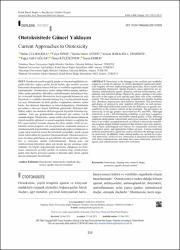| dc.contributor.author | Çulhaoğlu, Belde | |
| dc.contributor.author | Özer, Fulya | |
| dc.contributor.author | Aydın, Berna Deniz | |
| dc.contributor.author | Babaoğlu Demiröz, Gizem | |
| dc.contributor.author | Çağlar, Tuğçe Gül | |
| dc.contributor.author | Küçüköner, Ömer | |
| dc.contributor.author | Erbek, Seyra | |
| dc.date.accessioned | 2022-08-25T06:21:14Z | |
| dc.date.available | 2022-08-25T06:21:14Z | |
| dc.date.issued | 2021 | en_US |
| dc.identifier.citation | Çulhaoğlu, B., Özer, F., Aydın, B.D., Babaoğlu, Demiröz, G., Çağlar T.G., Küçüköner, Ö., Erbek, S. (2021). Ototoksisitede güncel yaklaşım. Kulak Burun Boğaz ve Baş Boyun Cerrahisi, 29(3), 210-221. Doi: 10.24179/kbbbbc.2021-81529 | en_US |
| dc.identifier.issn | 2149-0880 | |
| dc.identifier.uri | http://doi.org/10.24179/kbbbbc.2021-81529 | |
| dc.identifier.uri | https://hdl.handle.net/20.500.12712/33387 | |
| dc.description.abstract | Ototoksisite çeşitli terapötik ajanlar ve kimyasal maddelerle (organikçözücüler, boğucu gazlar, böcek ilaçları, ağır metaller, çevreselkimyasallar) karşılaşma sonucu koklear ve vestibüler organlarda oluşanhasarlanmadır. Ototoksisiteye neden olduğu bilinen ajanlar, antibiyotikler,antineoplastikler, diüretikler, antiinflamatuar, antimalaryal ilaçlarve ototopik ilaçlardır. Ototoksisite, korti organında bulunan dış şaçlıhücrelerde ve vestibüler sistemde bulunan Tip 1 tüy hücrelerinde hasarayol açar. Ototoksisite en fazla görülen semptomlar; tinnitus, işitmekaybı, baş dönmesi, hiperakuzi ve işitsel dolgunluktur. Ototoksisiteprevalansı ve derecesi, kişisel farklılıklar gösterebilir. Bu kişisel farklılıklar,tedavi¬nin ototoksik etkilerine genetik duyarlılık farkından kaynaklanır.Tüm yaş gruplarındaki ototoksisite pre¬valansı %4-90arasında değişir. Ototoksisite, yaşamı tehdit eden bir durum olmasa daönemli mesleki, eğitimsel ve sosyal sonuçlarla iletişim ve sağlıkla ilişkiliyaşam kalitesi üzerinde olumsuz bir etkisi olabilir. Etkili bir ototoksisiteizleme programı; saf ses odyometrisi, otoakustik emisyon veimmitansmetrik değerlendirme yapan temel odyolojik test bataryası veuygun takip testlerini içeren bir protokolü içermelidir, ancak yaygınolarak kabul edilen bir protokol bulunmamaktadır. Ototoksisitenin sonucumeydana gelen hasarı en aza indirmek için çeşitli tedavi yöntemlerive koruyucu ajanlar kullanılmaktadır. Bunun yanı sıraototoksisitenin önlenmesi adına çok sayıda hayvan çalışması yapılmaktadır.Bu bilgiler doğrultusunda hazırlamış olduğumuz bu derlemede,ototoksisite ayrıntılı şekilde ele alınmış olup, ototoksisiteyeneden olan ilaçlar, koruyucu ajanlar ve bununla ilgili olarak yapılanhayvan çalışmaları incelenmiştir. | en_US |
| dc.description.abstract | Ototoxicity is the damage to the cochlear and vestibular organs as a result of exposure to various therapeutic agents and chemicals (organic solvents, asphyxiant gases, pesticides, heavy metals, and environmental chemicals). Agents known to cause ototoxicity are antibiotics, antineoplastic agents, diuretics, and anti-inflammatory, antimalarial, and ototopical drugs. Ototoxicity causes damage to the outer hair cells in the organ of corti and the type I hair cells in the vestibular system. The most common ototoxicity symptoms are tinnitus, hearing loss, dizziness, hyperacusis, and auditory saturation. The prevalence and degree of ototoxicity may manifest differently in each person. These individual differences result from the difference in genetic susceptibility to the ototoxic effects of the treatment. The prevalence of ototoxicity in all age groups varies between 4% and 90%. Although ototoxicity is not a life-threatening condition, it can have a negative impact on communication and health-related quality of life, affecting important professional, educational, and social outcomes. Even though there is no widely accepted protocol, an effective ototoxicity monitoring program should include a protocol that includes pure tone audiometry, a basic audiological test battery for otoacoustic emission and immittance meter, and appropriate follow-up tests. Various treatment methods and protective agents are used to minimize the damage caused by ototoxicity. In addition, many animal studies are carried out to prevent ototoxicity. In this review, ototoxicity is discussed in detail in line with these considerations, and drugs that cause ototoxicity, protective agents, and related animal studies are examined. | en_US |
| dc.language.iso | tur | en_US |
| dc.publisher | Türkiye Klinikleri | en_US |
| dc.relation.isversionof | 10.24179/kbbbbc.2021-81529 | en_US |
| dc.rights | info:eu-repo/semantics/openAccess | en_US |
| dc.subject | ototoksisite | en_US |
| dc.subject | işitme kaybı | en_US |
| dc.subject | ototoksik ilaç | en_US |
| dc.subject | korucu ajanlar | en_US |
| dc.subject | hayvan modelleri | en_US |
| dc.subject | ototoxicity | en_US |
| dc.subject | hearing loss | en_US |
| dc.subject | protective agents | en_US |
| dc.subject | aminal models | en_US |
| dc.title | Ototoksisitede güncel yaklaşım | en_US |
| dc.title.alternative | Current approaches to ototoxicity | en_US |
| dc.type | article | en_US |
| dc.contributor.department | OMÜ, Sağlık Bilimleri Fakültesi, Odyoloji Bölümü | en_US |
| dc.contributor.authorID | 0000-0001-8121-8543 | en_US |
| dc.contributor.authorID | 0000-0002-0262-5093 | en_US |
| dc.contributor.institutionauthor | Çulhaoğlu, Belde | |
| dc.contributor.institutionauthor | Küçüköner, Ömer | |
| dc.identifier.volume | 29 | en_US |
| dc.identifier.issue | 3 | en_US |
| dc.identifier.startpage | 210 | en_US |
| dc.identifier.endpage | 221 | en_US |
| dc.relation.journal | Kulak Burun Boğaz ve Baş Boyun Cerrahisi | en_US |
| dc.relation.publicationcategory | Makale - Ulusal Hakemli Dergi - Kurum Öğretim Elemanı | en_US |
















